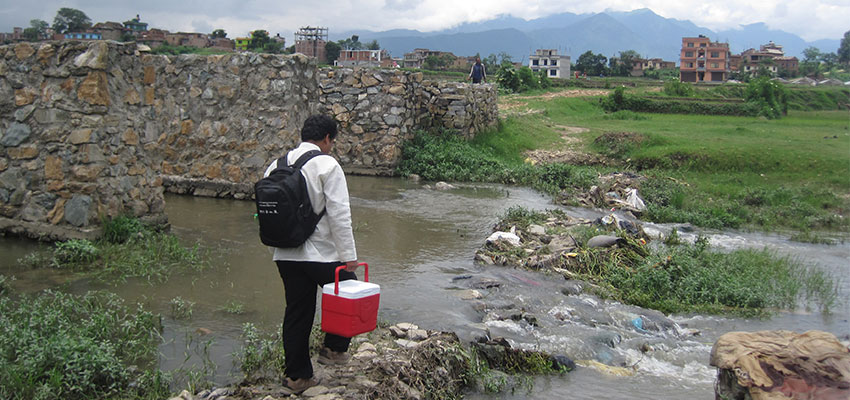
Shawn Wen, ’13 (Department of Brain and Cognitive Sciences), is in Nepal on a Fellowship from the Public Service Center funded by D-Lab Scale-Ups, our technology dissemination program. Shawn is gathering user feedback on the PortaTherm incubator for typhoid diagnostic and evaluation concept desirability and viability in Nepal. The PortaTherm, developed at D-Lab, is under review for entry into the full Scale-Ups technology dissemination pipeline.
Project overview
Each year, an estimated 21.6 million people worldwide develop enteric fever (which includes both typhoid and paratyphoid fever) is a water-borne bacterial disease from which over 200,000 die annually; 95% of cases occur in children under the age of 18.
n most parts of the world where typhoid is endemic, access to accurate diagnostic tests are not available because they lack the electricity, lab equipment, and trained personnel necessary for proper diagnosis. Misdiagnosis and mistreatment has led to the emergence of multi-antibiotic resistant strains, as well as avoidable morbidity and mortality.
To address the need for developing world-appropriate incubators to be used for diagnostic test cell cultivation, D-Lab developed the PortaTherm, a low-cost, easy-to-use, portable incubator that can be used off-grid. A complementary culture-based diagnostic test for typhoid was developed by our collaborators Dr. Jason Andrews and Dr. Elizabeth Hohmann at Massachusetts General Hospital (MGH) and is being used in a clinical study, by Dr Amit Arjyal at Patan Hospital in Nepal this summer. Shawn is there training Patan Hospital staff in using the PortaTherm and collecting user feedback. The information gained from June 2012 will form the basis for next steps in product development and dissemination strategy for the PortaTherm.
Shawn’s first report from the field follows:
June 12, 2012
The energy surrounding the PortaTherm incubator is extremely positive. The notion of an electricity-free incubator has created quite a bit of buzz around the lab and clinic, and lots of people want to see and learn to use it.
Dr. Arjyal, the principal investigator on the clinical trial, arranged housing for me in a guesthouse only about 2.5km from Patan Hospital, so I can easily walk to and from work, or catch the local tempo (bus) if it is too hot out.
I absolutely love the people I work with. I work most closely with Dr. Arjyal and another summer research assistant named Subarna who is a medical student from Case Western, but I have also gotten to know many of the doctors, nurses, and other researchers in our lab and typhoid clinic quite well.
1. Patient protocol at Patan Hospital (gathered from observation and conversations with doctors/nurses)
A triage nurse, who assesses how critical their condition is, takes in patients. The most critical get immediate attention. If it is not critical, patients are sent to the outpatient department.
In OPD, patients come in as early as 5am, take a number when the counter opens at 8am, and wait until their number is called. They are assessed and referred to different specialties where they take another number and wait. Sometimes, day-of care isn’t available, so patients have to return the following day. It's a nightmare to navigate. I can see why people would want to avoid seeking medical attention until absolutely necessary.
Decentralizing health care services like typhoid diagnostics and making it this available in more remote areas may enable more timely treatment.
2. Patan Hospital protocol for patient exhibiting typhoid symptoms (also obtained from observation and conversation)
All Emergency Room and Outpatient Department patients exhibiting fever, diarrhea, loss of appetite are referred to the typhoid clinic, where they are assessed and prescribed a very general antibiotic regimen for seven days (either ofloxacin or azithromycin).
A blood sample is taken and sent to a microbiology lab, where a blood culture is performed. The culture is incubated for up to seven days, and checked daily for signs of bacterial growth.
The sequence of subsequent steps necessary for confirming typhoid after culture is an extremely technical and lab-intensive process. These post-blood culture steps (subculture, biochemical assay, sensitivity test) are impossible in the resource-limited settings in which they hope to have an impact. However, because past studies have indicated that over 80% of gram-negative bacteria in Southeast Asia are Salmonella typhi or paratyphi, the ability to identify gram-negative bacteria in blood culture is huge advantage over no diagnostic test at all.
In this study, they will culture using both systems and report what percentage of cultures positive for gram-negative bacterial growth are actually typhi or paratyphi.
3. Qualitative interviews
In consultation with Dr. Arjyal and a doctor named Samir we decided to target the Lalitpur district for our interviews for the following reasons: 1) Samir's connections to the Department of Public Health district officer for Lalitpur, 2) the importance of the affiliation with Patan Hospital which would boost compliance, 3) Lalitpur has both rural and urban areas that can at least provide an initial representation of urban and rural areas in the country, and 4) Samir has a map of all government health centers.
The next steps are to get approval from the district officer and consult Samir's map to make a final list of government health centers we will visit. There are upwards of 50 health posts and sub-health posts (which are mostly found in more remote areas), and it is not feasible to visit them all, especially since the approaching monsoon rains frequently leave some roads inaccessible.
Additionally, because the purpose of this study is mostly to get a general sense idea of desirability and feasibility in each of these settings, it is not necessarily essential to visit and interview all the health care centers in Lalitpur, but we should still sample a large enough pool that it can accurately represent our targeted population.

